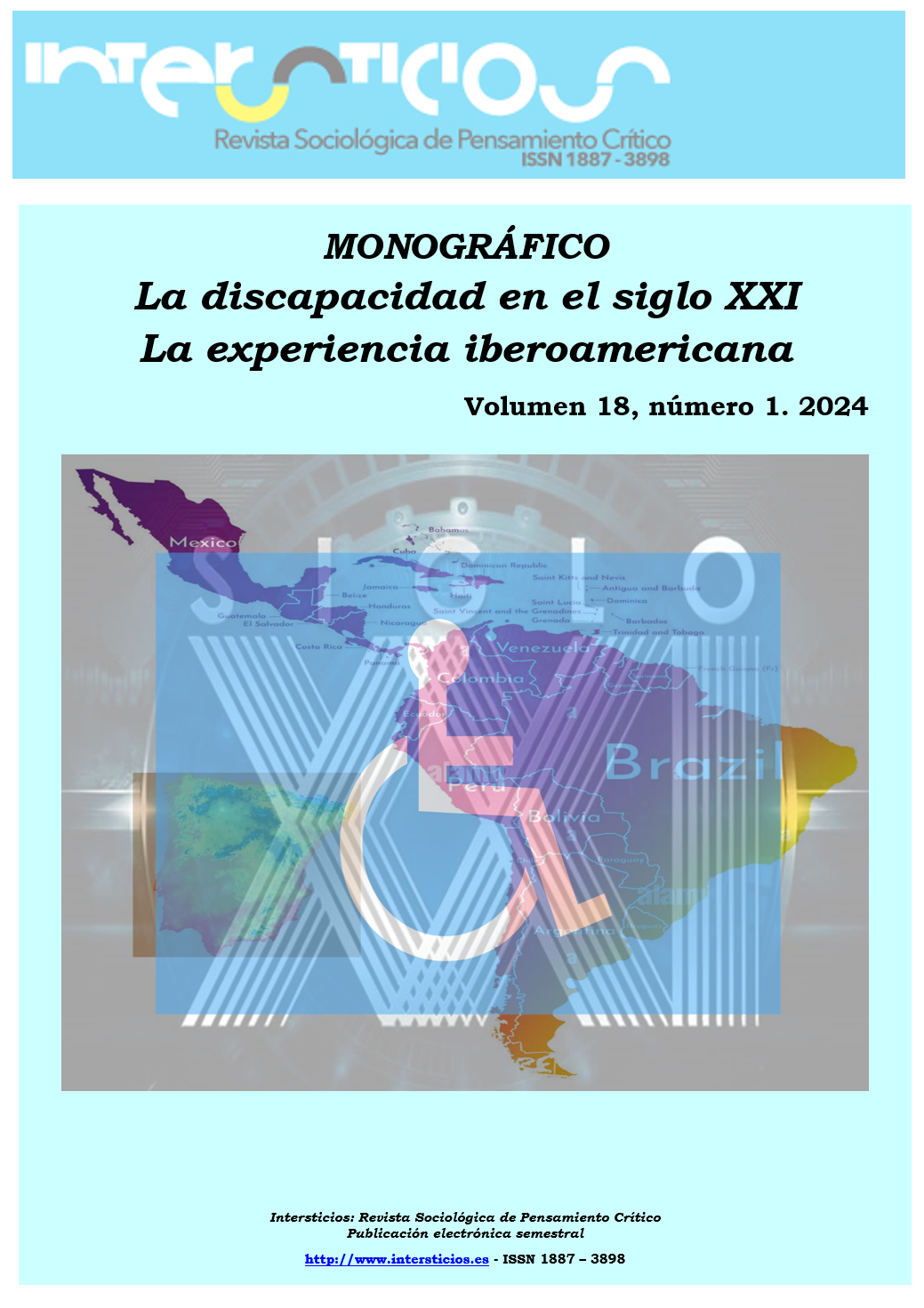Divided subjectivities: Biographical narratives of users of mental health services for depression
Keywords:
Biographical narratives, Depression, Mental health, Self-control, Doubling of the selfAbstract
The article describes and analyzes biographical narratives of people who suffer from depression and participate in therapeutic spaces. Specifically, it investigates the divisions of subjectivity or unfolding of the self as ways to make sense of the experiences of suffering and coping with depression. It presents results of an empirical investigation that uses the biographical method and analyzes interviews with users of mental health services in the City of Santa Fe, Argentina.
The article identifies two forms of division of subjectivity in biographical accounts, on the one hand, experiences of depression and, on the other, coping strategies. The first allude, on the one hand, to a deep split between the mind and the body and, on the other, to the presence of internal agents that hinder actions. Regarding the ways of coping with depression, one tactic is to integrate other inmates by listening and recognizing them, and the other is trying to resist by disobeying their demands. The article argues that these divisions of subjectivity help to make sense of discomfort and remove guilt by identifying internal agents that are foreign to the person. But, they also promote an individualistic understanding of depression that dissociates it from social contexts and relationships and reduces it to a break within the subject, who is responsible for their recovery.
References
Borotto, A. (2019): “No va más. Un estudio sociobiográfico de carreras morales de jugadores problemáticos de juegos de azar”, en Meccia, E. (Ed.), Biografías y sociedad. Métodos y perspectivas, Santa Fe: Ediciones UNL y Eudeba, pp.97-128.
Brinkmann, S. (2016): Diagnostic Cultures. A Cultural Approach to the Pathologization of Modern Life, Abingdon, Routledge.
Brookfield, S. (2011): “When the Black Dog Barks: An Autoethnography of Adult Learning in and on Clinical Depression”, 114, 155. https://doi.org/10.1002/ace
Chase, S. (2015): “Investigación narrativa”, en Denzin, N. y Y. Lincoln (Eds.), Métodos de recolección y análisis de datos, Buenos Aires, Gedisa, pp. 58-112.
Coll-Florit, M., Climent, S., Sanfilippo, M., y Hernández-Encuentra, E. (2021): “Metaphors of Depression. Studying First Person Accounts of Life with Depression Published in Blogs”, Metaphor and Symbol, 36(1), pp. 1–19. https://doi.org/10.1080/10926488.2020.1845096
Csordas, T. (2013): “Inferring immediacy in adolescent accounts of depression”, Journal of Consciousness Studies, 20(7-8), pp. 239-253.
Cvetkovich, A. (2012): Depression. A public feeling, Durham, Duke University Press.
Del Monaco, R. (2017): Idiomas del dolor crónico: experiencias y saberes a partir de la migraña, Buenos Aires, Biblos.
Ehrenberg, A. (2000): La fatiga de ser uno mismo. Depresión y sociedad, Buenos Aires, Nueva Visión.
Ehrenberg, A. (2016): “Beyond Depression: Personal Equation from the Guilty to the Capable Individual”, en Wakefield, J. y S. Demazeux (Eds.), Sadness or Depression? History, Philosophy and Theory of the Life Sciences, New York: Springer, pp. 39-54.
Elias, N. (1987): El proceso de la civilización. Investigaciones sociogenéticas y psicogenéticas, Madrid, Fondo de Cultura Económica.
Emmons, K. (2010): Black Dogs and Blue Words: Depression and Gender in the Age of Self-Care, London, Rutgers University Press.
Figueiras, M. (2021): Un perro rabioso: Noticias desde la depresión, Madrid, Taurus.
Flick, U. (2007): Introducción a la investigación cualitativa, Madrid, Morata Ediciones.
Fisher, M. (2018): Los fantasmas de mi vida, Buenos Aires, Caja Negra.
Frank, A. W. (1997): The wounded storyteller: body, illness, and ethics, Chicago, University Of Chicago.
Frank, A. W. (2012): “Practicing dialogical narrative analysis”, en Holstein, J. A. y J. Gubrium (Eds.), Varieties of Narrative Analysis, California, SAGE Publications, pp. 33-52.
Galasiński, D. (2008): Men’s Discourses of Depression, Basingstoke y New York, Palgrave MacMillan.
Good, B. (2003): Medicina, racionalidad y experiencia. Una perspectiva antropológica, Barcelona, Bellaterra.
Han, B.-C. (2012): La sociedad del cansancio, Barcelona, Herder.
Haroz, E. E., Ritchey, M., Bass, J. K., Kohrt, B. A., Augustinavicius, J., Michalopoulos, L., Burkey, M. D., y Bolton, P. (2017): “How is depression experienced around the world? A systematic review of qualitative literature”, Social Science and Medicine, 183, pp. 151–162. https://doi.org/10.1016/j.socscimed.2016.12.030
Jago, B. J. (2002): “Chronicling an Academic Depression”, Journal of Contemporary Ethnography, 31(6), pp. 729–757. https://doi.org/10.1177/089124102237823
Kangas, I. (2001): “Making sense of depression: Perceptions of melancholia in lay narratives”, Health, 5(1), pp. 76–92. https://doi.org/10.1177/136345930100500104
Karp, D. (2006): Is it me or my meds? Living with Antidepressants, London, Harvard University Press.
Karp, D. (2017): Speaking of sadness. Depression, disconnection, and the meanings of illness, Estados Unidos, Oxford Press.
Kleinman, A., y Good, B. (1985): Culture and depression. Studies in the anthropology and cross-cultural psychiatry of affect and disorder, Berkeley, University of California Press.
Korman, G., y Idoyaga Molina, A. (2010): Cultura y depresión. Aportes antropológicos para la conceptualización de los trastornos mentales, Buenos Aires, Akadia.
Körner, H., Newman, C., Mao, L., Kidd, M. R., Saltman, D., y Kippax, S. (2011): “«The black dog just came and sat on my face and built a kennel»: Gay men making sense of «depression»”, Health, 15(4), pp. 417-436. https://doi.org/10.1177/1363459310372511
Kotliar, D. M. (2016): “Depression Narratives in Blogs: A Collaborative Quest for Coherence”, Qualitative Health Research, 26(9), pp. 1203–1215. https://doi.org/10.1177/1049732315612715
Lakoff, G. y Johnson, M. (2009): Metáforas de la vida cotidiana, Madrid, Cátedra.
Latour, B. (2008): Reensamblando lo social: una introducción a la teoría del actor-red, Buenos Aires, Manantial.
Lupton, D. (1997): Imperative of Health. Public Health and the Regulated Body, London, Sage Publications.
Luxardo, N. (2008): “Entre la narrativa y la vivencia. Lecturas a partir del cáncer”, Revista Sociales Nueva Época, 4, 30–38. Recuperado de http://publicaciones.cucsh.udg.mx/pperiod/estsoc/pdf/estsoc_4/Seccionarticulos1.pdf
Martínez Hernáez, Á. (2017): “«El secreto está en mi interior». La neuropolítica y la emergencia de las neuronarrativas en el consumo de antidepresivos”, en Comelles, J. M. y E. Perdiguero-Gil (Eds.), Educación, comunicación y salud, perspectivas desde las ciencias humanas y sociales, Tarragona, Publicacions Universitat Rovira i Virgili, pp. 305–320.
Martuccelli, D. (2007): Cambio de rumbo. La sociedad a escala del individuo, Santiago de Chile, LOM Ediciones.
Mays, J. (1995): In the Jaws of the Black Dogs: A Memoir of Depression, Toronto, Viking.
Meccia, E. (2012): “Subjetividades en el puente. El método biográfico y el análisis microsociológico del tránsito de la homosexualidad a la gaycidad”, Revista Latinoamericana de Metodología En Investigación Social, 4(2), pp. 38–51.
Meccia, E. (2017): El tiempo no para. Los últimos homosexuales cuentan la historia, Santa Fe, Eudeba y Ediciones UNL.
Meccia, E. (2019a): “Cuéntame tu vida. Análisis sociobiográfico de narrativas del yo”, en Meccia, E. (Ed.), Biografías y sociedad. Métodos y perspectivas, Santa Fe, Ediciones UNL y Eudeba, pp. 63-96.
Meccia, E. (2019b): “Una ventana al mundo. Investigar biografías y sociedad”, en Meccia, E. (Ed.), Biografías y sociedad. Métodos y perspectivas, Santa Fe, Ediciones UNL y Eudeba, pp. 25-62.
Muñiz Terra, L., Frassa, M. J., y Bidauri, M. P. (2018): “Hacia un encuentro de reflexividades: la entrevista biográfica como interludio del proceso de investigación social”, en J. I. Piovani y L. Muñiz Terra (Eds.), ¿Condenados a la reflexividad? Apuntes para repensar el proceso de investigación social, Buenos Aires, Biblos-CLACSO, pp. 120-146.
Murray, L. (2011): Killing the Black Dog: A Memoir of Depression, Farrar, Straus and Giroux, Australia.
Organización Mundial de la Salud. (2021): Depresión. Organización mundial de Salud. Recuperado de: https://tinyurl.com/2p82ksjp
Otero, M. (2015): “El «éxito» de la depresión como figura emblemática de las tensiones sociales contemporáneas”, Revista Tempora, 18, pp. 59–73.
Peters, G. (2021): “O novo espírito da depressão”, Civitas - Revista de Ciências Sociais, 21(1), pp. 71–83. https://doi.org/10.15448/1984-7289.2021.1.39150
Petersen, A. (2009): “Depression – A social pathology of action”, Irish Journal of Sociology, 17(2), pp. 56–71. https://doi.org/10.7227/IJS.17.2.5
Petersen, A. (2011): “Authentic self-realization and depression”, International Sociology, 26(1), pp. 5–24. https://doi.org/10.1177/0268580910380980
Plummer, K. (1995): Telling sexual stories: power, change, and social worlds, USA y Canada, Routledge.
Prati, R. (2020): “El malestar que sí tiene nombre”, Revista Diferencia(S), 10, pp. 77–88.
Prati, R. (2023): “El peso del pensamiento. Debates fenomenológicos en torno al dualismo y la depresión”, Ideas. Revista de filosofía moderna y contemporánea, 17, pp. 16-45.
Ratcliffe, M. (2015): Experiences of Depression: A Study in Phenomenology, United Kingdom: Oxford University Press.
Ridge, D., y Ziebland, S. (2006): “«The old me could never have done that»: How people give meaning to recovery following depression”, Qualitative Health Research, 16(8), pp. 1038–1053. https://doi.org/10.1177/1049732306292132
Ridge, D. (2009): Recovery from Depression Using the Narrative Approach, London, Jessica Kingsley Publishers.
Ridge, D., y Ziebland, S. (2012): “Understanding depression through a “coming out” framework”, Sociology of Health and Illness, 34(5), pp. 730–745. https://doi.org/10.1111/j.1467-9566.2011.01409.x
Ridge, D. (2018): “Making sense of the evolving nature of depression narratives and their inherent conflicts”, Subjectivity, 11(2), pp. 144–160. https://doi.org/10.1057/s41286-018-0048-z
Rønberg, M. (2017): “Struggling with a Depression Diagnosis: Negotiations with Diagnostic Categories”, Nordic Psychology, 69 (1), pp. 5–18.
Rønberg, M. T. (2019): “Living under a diagnostic description: navigating images, metaphors, and sounds of depression”, Subjectivity, 12(2), pp. 171–191. https://doi.org/10.1057/s41286-019-00070-z
Roystonn, K., Teh, W. L., Samari, E., Cetty, L., Devi, F., Shahwan, S., Chandwani, N., y Subramaniam, M. (2021): “Analysis and Interpretation of Metaphors: Exploring Young Adults’ Subjective Experiences With Depression”, Qualitative Health Research, 31(8), 1437-1447. https://doi.org/10.1177/10497323211004104
Sadowsky, J. (2022): El imperio de la depresión, España, Alianza Editorial.
Sampietro, H. M. (2016): “Del diagnóstico al activismo, un proceso personal de empoderamiento”, Rev. Asoc. Esp. Neuropsiq., 36(129), pp. 193–207. https://doi.org/10.4321/S0211-57352016000100013
Sontag, S. (2008): La enfermedad y sus metáforas. El sida y sus metáforas, España: Debolsillo.
Svenaeus, F. (2014): “Depression and the Self. Bodily Resonance and Attuned Being-in-the-World”, en Ratcliffe, M. y A. Stephan (Eds.), Depression, Emotion and the Self Philosophical and Interdisciplinary Perspectives, United Kingdom, Imprint Academic.
Trivelli, E. (2014): “Depression, performativity and the conflicted body: An auto-ethnography of self-medication”, Subjectivity, 7(2), pp. 151-170. https://doi.org/10.1057/sub.2014.4
Wakefield, J. C. y Demazeux, S. (2016): “Introduction: Depression, one and many”, en Wakefield, J. C. y S., Demazeux (Eds.), Sadness or depression? International perspectives on the depression epidemic and its meaning, New York, Springer, pp.1-16.
Weinberg, D. (2005): Of Others inside: Insanity, Addiction, and Belonging in America, Philadelphia, Temple University press.
Zapata Hidalgo, M. (2019): “La depresión y su recuperación. Una etnografía feminista y corporal”, (Tesis doctoral, Facultad de Educación, Filosofía y Antropología, Donostia, España).









